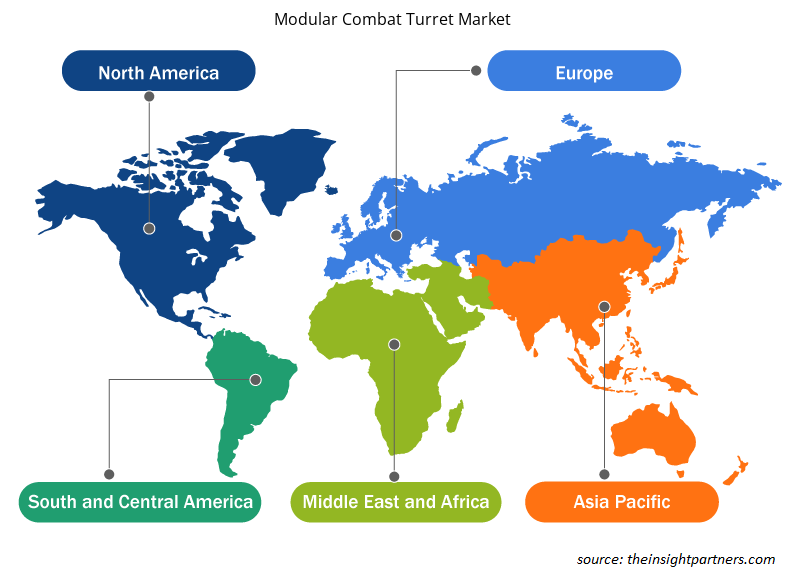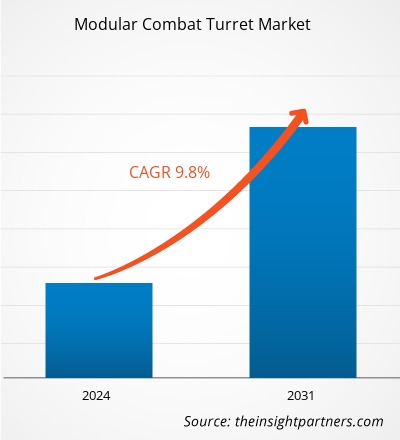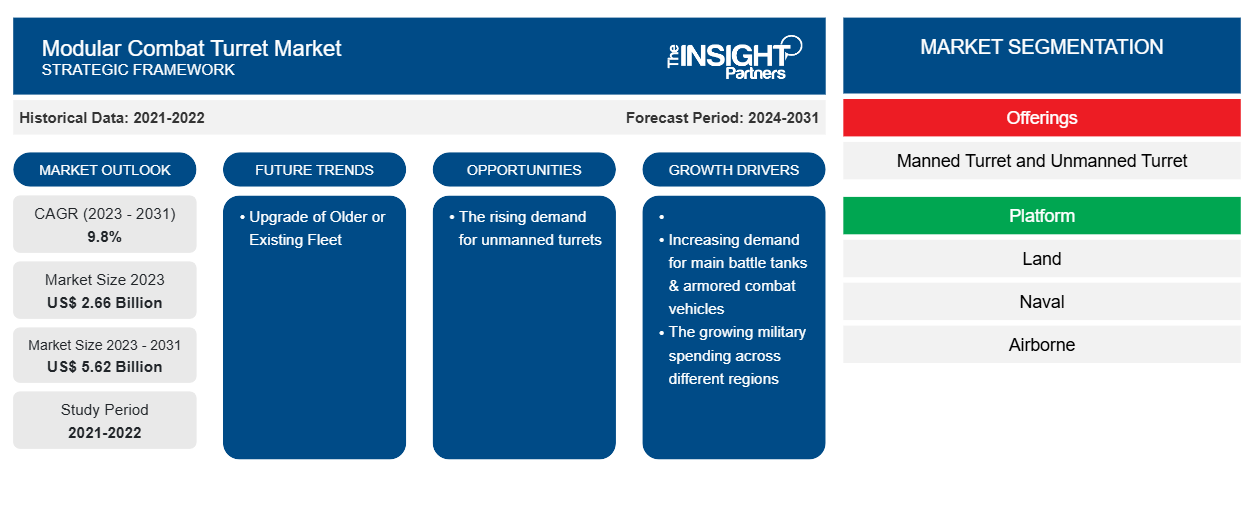Si prevede che la dimensione del mercato delle torrette da combattimento modulari raggiungerà i 5,62 miliardi di dollari entro il 2031, rispetto ai 2,66 miliardi di dollari del 2023. Si prevede che il mercato registrerà un CAGR del 9,8% nel periodo 2023-2031. È probabile che la crescente domanda di torrette senza pilota rimanga una tendenza chiave nel mercato.
Analisi del mercato delle torrette da combattimento modulari
I grandi e affermati produttori di torrette stanno investendo una notevole quantità di denaro nella produzione di torrette sia senza equipaggio che con equipaggio. Le forze di difesa e i produttori di veicoli corazzati sono i principali acquirenti di torrette da combattimento modulari. Poiché l'approvvigionamento di veicoli corazzati per trasporto personale, navi militari, portaerei, fregate e carri armati tra le forze militari sta aumentando a un ritmo considerevole, il che ha mostrato un potere contrattuale costantemente più elevato degli acquirenti nel mercato delle torrette da combattimento modulari. Inoltre, le forze di difesa stanno facendo pressione sui produttori di veicoli corazzati per fornire veicoli in volumi maggiori, il che sta evidenziando la pressione sui produttori di torrette. Si prevede inoltre che il costante aumento dell'adozione dei veicoli sopra menzionati svilupperà il potere contrattuale degli acquirenti durante il periodo di previsione.
Panoramica del mercato delle torrette da combattimento modulari
I principali stakeholder nell'ecosistema globale del mercato delle torrette da combattimento modulari includono produttori di componenti, produttori e fornitori di torrette e utenti finali. Con la crescente domanda di torrette da combattimento modulari in tutto il mondo, anche i fornitori di componenti di torrette stanno riscontrando un aumento della domanda. I componenti del sistema di torrette includonocontroller motore , unità di potenza, unità di stabilizzazione, azionamento torretta, tra gli altri. L'impatto diretto dell'elevata domanda è tuttavia sui fornitori/produttori di torrette da combattimento modulari che soddisfano una varietà di esigenze militari e di difesa. La crescente spesa per la capacità militare e di difesa e la crescente necessità di sostituire vecchi e obsoleti carri armati e sistemi sta creando la domanda di torrette da combattimento modulari. Alcuni dei principali fornitori di soluzioni per torrette da combattimento modulari che operano nel mercato globale includono: BAE Systems, Control Solution LLC, Curtiss-Wright Corporation, Denel Dynamics, Elbit System Ltd., Jenoptik AG, Leonardo SPA, Moog Inc., Rheinmetall AG tra gli altri
Personalizza questo report in base alle tue esigenze
Riceverai la personalizzazione gratuita di qualsiasi report, comprese parti di questo report, o analisi a livello nazionale, pacchetto dati Excel, oltre a usufruire di grandi offerte e sconti per start-up e università
-
Scopri le principali tendenze di mercato in questo rapporto.Questo campione GRATUITO includerà analisi di dati che spaziano dalle tendenze di mercato alle stime e alle previsioni.
Driver e opportunità di mercato per le torrette da combattimento modulari
Aumento della spesa militare
Il rapido cambiamento nella guerra moderna ha spinto i governi a stanziare importi maggiori per le rispettive forze militari. Il budget stanziato per l'esercito aiuta le forze militari a impegnarsi nello sviluppo di solide tecnologie indigene e nell'approvvigionamento di armi, armamenti, veicoli e altre attrezzature avanzate da produttori internazionali. C'è un aumento nella modernizzazione di soldati e veicoli militari tra la maggior parte delle forze militari al fine di mantenere il personale e i veicoli pronti per la missione. Con l'obiettivo di modernizzare soldati e veicoli, i ministeri della difesa in tutto il mondo stanno investendo ingenti somme in tecnologie più recenti, tra cui la torretta da combattimento modulare avanzata. Questo fattore sta stimolando la crescita del mercato globale della torretta da combattimento modulare. Secondo lo Stockholm International Peace Research Institute (SIPRI), la spesa militare globale è salita a 2.443 miliardi di dollari nel 2023, registrando un aumento di circa il 13% rispetto al 2022. I paesi chiave nel 2023, che hanno rappresentato circa il 60% della spesa globale, includono Stati Uniti, Cina, India, Russia e Arabia Saudita. Tali investimenti hanno incrementato gli acquisti e gli ordini di torrette da combattimento modulari militari da diversi paesi in tutto il mondo, stimolando ulteriormente la crescita del mercato.
Aggiornamento di una flotta più vecchia o esistente
C'è una crescente necessità di aggiornare o sostituire vecchi carri armati e veicoli blindati. I paesi hanno speso cifre enormi in questa direzione. Ad esempio, cinque dei maggiori investitori in queste flotte includono Cina, India, Australia, Pakistan e Corea del Sud. La Cina ha investito più di 15 miliardi di dollari USA per sostituire migliaia di veicoli obsoleti e obsoleti nel 2023. L'India è anche uno dei mercati più importanti per i carri armati da combattimento principali. Si prevede che il paese spenderà in modo significativo nel programma Future Infantry Combat Vehicle, che mira a sostituire oltre 2000 BMP-2 IFV. Inoltre, è probabile che l'esercito indiano emetta una richiesta di proposta (RFP) nel 2024 per un mega progetto del valore stimato di 6,84 miliardi di dollari USA. Il Pakistan sta anche rispondendo all'aumento degli acquisti di tali veicoli da parte del governo indiano. Il paese sta investendo molto nei propri progetti e quindi sta emergendo come uno dei principali acquirenti di flotte di veicoli militari e di difesa. Oltre a questi paesi, anche Singapore e Indonesia stanno acquistando flotte di veicoli nuove e aggiornate. È probabile che tali fattori creino nuove opportunità per le torrette da combattimento modulari nei prossimi anni in diverse regioni.
Analisi della segmentazione del rapporto di mercato delle torrette da combattimento modulari
I segmenti chiave che hanno contribuito alla derivazione dell'analisi di mercato delle torrette da combattimento modulari sono le offerte e la piattaforma.
- In base all'offerta, il mercato delle torrette da combattimento modulari è segmentato in torrette con equipaggio e torrette senza equipaggio. Il segmento delle torrette con equipaggio ha detenuto una quota di mercato maggiore nel 2023.
- In base alla piattaforma, il mercato delle torrette da combattimento modulari è segmentato in terrestre, navale e aviotrasportato. Il segmento terrestre ha detenuto una quota di mercato maggiore nel 2023.
Analisi della quota di mercato delle torrette da combattimento modulari per area geografica
L'ambito geografico del rapporto sul mercato delle torrette da combattimento modulari è suddiviso principalmente in cinque regioni: Nord America, Europa, Asia Pacifico, Medio Oriente e Africa e Sud America.
Il Nord America ha dominato il mercato nel 2023, seguito da Europa e regioni dell'Asia Pacifica. Inoltre, è probabile che anche l'Asia Pacifica assista al CAGR più elevato nei prossimi anni. Gli Stati Uniti hanno dominato il mercato delle torrette da combattimento modulari del Nord America nel 2023. Gli Stati Uniti sono un paese tecnologicamente avanzato noto per l'adozione di tecnologie in una fase iniziale. Il paese mantiene la prima posizione come potenza militare indiscussa in tutto il mondo sia nel contesto del personale che della tecnologia. Nel 2023, gli Stati Uniti hanno speso 916 miliardi di dollari in spese militari. Più forte è l'esercito del paese, maggiore è la spesa per l'acquisto di tecnologie, tra cui le torrette da combattimento modulari. Inoltre, la presenza nel paese di aziende come CMI Group, Control Solutions LLC, Curtiss-Wright Corporation e Lockheed Martin Corporation è un altro fattore dopo la spesa militare più elevata che aiuterà a influenzare la crescita del mercato. Inoltre, il paese ha sperimentato poche iniziative che si prevede contribuiranno in modo significativo alla crescita del mercato.
Approfondimenti regionali sul mercato delle torrette da combattimento modulari
Le tendenze regionali e i fattori che influenzano il mercato delle torrette da combattimento modulari durante il periodo di previsione sono stati ampiamente spiegati dagli analisti di Insight Partners. Questa sezione discute anche i segmenti e la geografia del mercato delle torrette da combattimento modulari in Nord America, Europa, Asia Pacifico, Medio Oriente e Africa e America meridionale e centrale.

- Ottieni i dati specifici regionali per il mercato delle torrette da combattimento modulari
Ambito del rapporto di mercato sulle torrette da combattimento modulari
| Attributo del report | Dettagli |
|---|---|
| Dimensioni del mercato nel 2023 | 2,66 miliardi di dollari USA |
| Dimensioni del mercato entro il 2031 | 5,62 miliardi di dollari USA |
| CAGR globale (2023-2031) | 9,8% |
| Dati storici | 2021-2022 |
| Periodo di previsione | 2024-2031 |
| Segmenti coperti |
Per offerte
|
| Regioni e Paesi coperti |
America del Nord
|
| Leader di mercato e profili aziendali chiave |
|
Densità dei giocatori del mercato delle torrette da combattimento modulari: comprendere il suo impatto sulle dinamiche aziendali
Il mercato delle torrette da combattimento modulari sta crescendo rapidamente, spinto dalla crescente domanda degli utenti finali dovuta a fattori quali l'evoluzione delle preferenze dei consumatori, i progressi tecnologici e una maggiore consapevolezza dei vantaggi del prodotto. Con l'aumento della domanda, le aziende stanno ampliando le loro offerte, innovando per soddisfare le esigenze dei consumatori e capitalizzando sulle tendenze emergenti, il che alimenta ulteriormente la crescita del mercato.
La densità degli operatori di mercato si riferisce alla distribuzione di aziende o società che operano in un particolare mercato o settore. Indica quanti concorrenti (operatori di mercato) sono presenti in un dato spazio di mercato in relazione alle sue dimensioni o al valore di mercato totale.
Le principali aziende che operano nel mercato delle torrette da combattimento modulari sono:
- Sistemi BAE
- Soluzione di controllo LLC
- Società per azioni Curtiss-Wright
- Dinamica Denel
- Società a responsabilità limitata
Disclaimer : le aziende elencate sopra non sono classificate secondo un ordine particolare.

- Ottieni una panoramica dei principali attori del mercato delle torrette da combattimento modulari
Notizie e sviluppi recenti sul mercato delle torrette da combattimento modulari
Il mercato delle torrette da combattimento modulari viene valutato raccogliendo dati qualitativi e quantitativi dopo la ricerca primaria e secondaria, che include importanti pubblicazioni aziendali, dati di associazioni e database. Di seguito sono elencati alcuni degli sviluppi nel mercato delle torrette da combattimento modulari:
- Il programma Challenger 3 ha raggiunto un traguardo importante. È stato firmato il contratto per Rheinmetall BAE Systems Land (RBSL) per la fornitura di un nuovo sistema di corazzatura modulare sul carro armato da battaglia principale Challenger 3. (Fonte: Rheinmetall BAE Systems Land, comunicato stampa, gennaio 2024)
- John Cockerill è orgoglioso di presentare al DSEI 2023 la sua innovativa gamma di prodotti che combinano modularità, affidabilità e alte prestazioni, il veicolo Cockerill iX e la torretta Cockerill 1030. John Cockerill presenta anche la versione da 30 mm del Tank Boat. (Fonte: John Cockerill, comunicato stampa, settembre 2023)
Copertura e risultati del rapporto sul mercato delle torrette da combattimento modulari
Il rapporto "Dimensioni e previsioni del mercato delle torrette da combattimento modulari (2021-2031)" fornisce un'analisi dettagliata del mercato che copre le seguenti aree:
- Dimensioni e previsioni del mercato delle torrette da combattimento modulari a livello globale, regionale e nazionale per tutti i segmenti di mercato chiave coperti dall'ambito
- Tendenze del mercato delle torrette da combattimento modulari e dinamiche di mercato come driver, vincoli e opportunità chiave
- Analisi dettagliata delle cinque forze di Porter
- Analisi di mercato del mercato delle torrette da combattimento modulari che copre le principali tendenze del mercato, il quadro globale e regionale, i principali attori, le normative e i recenti sviluppi del mercato
- Analisi del panorama industriale e della concorrenza che copre la concentrazione del mercato, l'analisi della mappa di calore, i principali attori e gli sviluppi recenti per il mercato delle torrette da combattimento modulari
- Profili aziendali dettagliati
- Analisi storica (2 anni), anno base, previsione (7 anni) con CAGR
- Analisi PEST e SWOT
- Valore/volume delle dimensioni del mercato - Globale, Regionale, Nazionale
- Industria e panorama competitivo
- Set di dati Excel
Report recenti
Testimonianze
Motivo dell'acquisto
- Processo decisionale informato
- Comprensione delle dinamiche di mercato
- Analisi competitiva
- Analisi dei clienti
- Previsioni di mercato
- Mitigazione del rischio
- Pianificazione strategica
- Giustificazione degli investimenti
- Identificazione dei mercati emergenti
- Miglioramento delle strategie di marketing
- Aumento dell'efficienza operativa
- Allineamento alle tendenze normative























 Ottieni un campione gratuito per - Mercato delle torrette da combattimento modulari
Ottieni un campione gratuito per - Mercato delle torrette da combattimento modulari